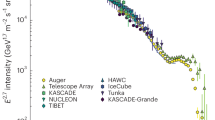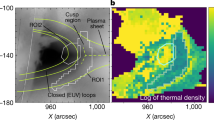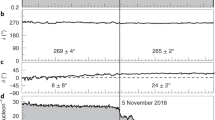Abstract
NASA’s Parker Solar Probe mission1 recently plunged through the inner heliosphere of the Sun to its perihelia, about 24 million kilometres from the Sun. Previous studies farther from the Sun (performed mostly at a distance of 1 astronomical unit) indicate that solar energetic particles are accelerated from a few kiloelectronvolts up to near-relativistic energies via at least two processes: ‘impulsive’ events, which are usually associated with magnetic reconnection in solar flares and are typically enriched in electrons, helium-3 and heavier ions2, and ‘gradual’ events3,4, which are typically associated with large coronal-mass-ejection-driven shocks and compressions moving through the corona and inner solar wind and are the dominant source of protons with energies between 1 and 10 megaelectronvolts. However, some events show aspects of both processes and the electron–proton ratio is not bimodally distributed, as would be expected if there were only two possible processes5. These processes have been very difficult to resolve from prior observations, owing to the various transport effects that affect the energetic particle population en route to more distant spacecraft6. Here we report observations of the near-Sun energetic particle radiation environment over the first two orbits of the probe. We find a variety of energetic particle events accelerated both locally and remotely including by corotating interaction regions, impulsive events driven by acceleration near the Sun, and an event related to a coronal mass ejection. We provide direct observations of the energetic particle radiation environment in the region just above the corona of the Sun and directly explore the physics of particle acceleration and transport.
This is a preview of subscription content, access via your institution
Access options
Access Nature and 54 other Nature Portfolio journals
Get Nature+, our best-value online-access subscription
$29.99 / 30 days
cancel any time
Subscribe to this journal
Receive 51 print issues and online access
$199.00 per year
only $3.90 per issue
Buy this article
- Purchase on Springer Link
- Instant access to full article PDF
Prices may be subject to local taxes which are calculated during checkout




Similar content being viewed by others
Data availability
All data used in this study is available to the public via NASA’s Space Physics Data Facility (SPDF) at https://spdf.gsfc.nasa.gov/.
References
Fox, N. J. et al. The Solar Probe Plus mission: humanity’s first visit to our star. Space Sci. Rev. 204, 7–48 (2016).
Mason, G. M. 3He-rich solar energetic particle events. Space Sci. Rev. 130, 231–242 (2007).
Desai, M. I. & Giacalone, J. Large gradual solar energetic particle events. Living Rev. Sol. Phys. 13, 3 (2016).
Reames, D. V. Solar Energetic Particles: A Modern Primer on Understanding Sources, Acceleration and Propagation (Springer, 2017).
Cane, H. V., Richardson, I. G. & von Rosenvinge, T. T. A study of solar energetic particle events of 1997–2006: their composition and associations. J. Geophys. Res. Space Phys. 115, A08101 (2010).
Wibberenz, G. & Cane, H. V. Multi-spacecraft observations of solar flare particles in the inner heliosphere. Astrophys. J. 650, 1199–1207 (2006).
McComas, D. J. et al. Integrated Science Investigation of the Sun (ISIS): design of the energetic particle investigation. Space Sci. Rev. 204, 187–256 (2016).
Kasper, J. C. et al. Solar Wind Electrons Alphas and Protons (SWEAP) investigation: design of the solar wind and coronal plasma instrument suite for Solar Probe Plus. Space Sci. Rev. 204, 131–186 (2016).
Bale, S. D. et al. The FIELDS instrument suite for Solar Probe Plus. Measuring the coronal plasma and magnetic field, plasma waves and turbulence, and radio signatures of solar transients. Space Sci. Rev. 204, 49–82 (2016).
Vourlidas, A. et al. The Wide-field Imager for Solar Probe Plus (WISPR). Space Sci. Rev. 204, 83–130 (2016).
Pizzo, V. A three-dimensional model of corotating streams in the solar wind, 1. Theoretical foundations. J. Geophys. Res. 83, 5563 (1978).
Gosling, J. Corotating and transient solar wind flows in three dimensions. Annu. Rev. Astron. Astrophys. 34, 35–73 (1996).
Kasper, J. C. et al. Alfvénic velocity spikes and rotational flows in the near-Sun solar wind. Nature https://doi.org/10.1038/s41586-019-1813-z (2019).
Bale, S. D. et al. Highly structured slow solar wind emerging from an equatorial coronal hole. Nature https://doi.org/10.1038/s41586-019-1818-7 (2019).
Kouloumvakos, A. et al. Connecting the properties of coronal shock waves with those of solar energetic particles. Astrophys. J. 876, 80 (2019).
Chotoo, K. et al. The suprathermal seed population for corotating interaction region ions at 1 au deduced from composition and spectra of H+, He++, and He+ observed on Wind. J. Geophys. Res. Space Phys. 105, 23107–23122 (2000).
Giacalone, J., Jokipii, J. R. & Kota, J. Particle acceleration in solar wind compression regions. Astrophys. J. 573, 845–850 (2002).
Zwickl, R. D., Roelof, E. C., Gold, R. E., Krimigis, S. M. & Armstrong, T. P. Z-rich solar particle event characteristics 1972–1976. Astrophys. J. 225, 281–303 (1978).
Reinhard, R. & Wibberenz, G. Propagation of flare protons in the solar atmosphere. Sol. Phys. 36, 473–494 (1974).
Kallenrode, M. B. Particle propagation in the inner heliosphere. J. Geophys. Res. Space Phys. 98, 19037–19047 (1993).
Richardson, I. G., von Rosenvinge, T. T. & Cane, H. V. The properties of solar energetic particle event-associated coronal mass ejections reported in different CME catalogs. Sol. Phys. 290, 1741–1759 (2015).
Wiedenbeck, M. E. et al. Observations of solar energetic particles from 3He-rich events over a wide range of heliographic longitude. Astrophys. J. 762, 54 (2013).
Bučik, R. et al. 3He-rich solar energetic particles from sunspot jets. Astrophys. J. Lett. 869, 21 (2018).
Bučik, R., et al. Multi-spacecraft observations of recurrent 3He-rich solar energetic particles. Astrophys. J. 786, 71 (2014).
Nitta, N. V., Mason, G. M., Wang, L., Cohen, C. M. S. & Wiedenbeck, M. E. Solar sources of 3He-rich solar energetic particle events in solar cycle 24. Astrophys. J. 806, 235 (2015).
Howard, R. A. Sun Earth Connection Coronal and Heliospheric Investigation (SECCHI). Adv. Space Res. 29, 2017–2026 (2002).
Thernisien, A., Vourlidas, A. & Howard, R. Forward modeling of coronal mass ejections using STEREO/SECCHI data. Sol. Phys. 256, 111 (2009).
Rouillard, A. P. et al. A solar storm observed from the Sun to Venus using the STEREO, Venus Express, and MESSENGER spacecraft. J. Geophys. Res. 114, A07106 (2010).
Wood, B. & Howard, R. An empirical reconstruction of the 2008 April 26 coronal mass ejection. Astrophys. J. 702, 901–910 (2009).
Isavnin, A. FRiED: a novel three-dimensional model of coronal mass ejections. Astrophys. J. 833, 10 (2016).
Acknowledgements
We are indebted to everyone who helped make the PSP mission possible. In particular, we thank all of the scientists, engineers, technicians, and administrative support people across all of the IS☉IS institutions that produced and supported the IS☉IS instrument suite and support its operations and the scientific analysis of its data. This work was supported as a part of the PSP mission under contract NNN06AA01C. S.D.B. acknowledges the support of the Leverhulme Trust Visiting Professorship programme and A.P.R. acknowledges financial support from the ANR project COROSHOCK ANR-17-CE31-0006-01 and from the ERC project SLOW_SOURCE – DLV-819189.
Author information
Authors and Affiliations
Contributions
D.J.M. is IS☉IS Principal Investigator (PI) and led the data analysis and writing of the study. E.R.C. is IS☉IS Deputy PI, helped develop EPI-Hi, and participated in the data analysis. C.M.S.C. helped develop EPI-Hi and participated in the data analysis. A.C.C. helped develop EPI-Hi and participated in the data analysis. A.J.D. helped develop EPI-Hi and participated in the data analysis. M.I.D. participated in the data analysis. J.G. participated in the data analysis. M.E.H. helped develop EPI-Lo and participated in the data analysis. C.J.J. produced Figs. 3, 4 and participated in the data analysis. S.M.K. participated in the data analysis. A.W.L. helped develop EPI-Hi and participated in the data analysis. R.A.L. helped develop EPI-Hi and participated in the data analysis. O.M. participated in the data analysis. W.H.M. participated in the data analysis. R.L.M. led the development of EPI-Lo and participated in the data analysis. R.A.M. helped develop EPI-Hi and participated in the data analysis. D.G.M. helped develop EPI-Lo and participated in the data analysis. A.P. participated in the data analysis. J.S.R. helped develop EPI-Hi and participated in the data analysis. E.C.R. participated in the data analysis. N.A.S. led the development of the IS☉IS Science Operations Center and participated in the data analysis. E.C.S. helped develop EPI-Hi and participated in the data analysis. J.R.S. led the development of the analysis tool, produced Figs. 1, 2, and participated in the data analysis. M.E.W. led the development of EPI-Hi and participated in the data analysis. S.D.B. is FIELDS PI and participated in the data analysis. J.C.K. is SWEAP PI and participated in the data analysis. A.W.C. helped develop SWEAP and participated in the data analysis. K.E.K. helped develop SWEAP and participated in the data analysis. R.J.M. helped develop FIELDS and participated in the data analysis. M.P. helped develop FIELDS and participated in the data analysis. M.L.S. helped develop SWEAP and participated in the data analysis. A.P.R. led the CME simulation work and participated in the data analysis.
Corresponding author
Ethics declarations
Competing interests
The authors declare no competing interests.
Additional information
Publisher’s note Springer Nature remains neutral with regard to jurisdictional claims in published maps and institutional affiliations.
Peer review information Nature thanks Hazel Bain and Monica Laurenza for their contribution to the peer review of this work.
Extended data figures and tables
Extended Data Fig. 1 Viewing geometry and observation of coronal mass ejection.
a, A view of the ecliptic plane from solar north at 14:00 10 November 2018 ut showing the relative positions of STEREO-A and PSP. The dashed curves, from innermost to outermost, represent the orbits of Mercury, Venus and Earth. The red area shows the field of view of the COR-2 instrument onboard STEREO-A. A CME off the east limb of the Sun as viewed from STEREO-A would be roughly propagating towards PSP. This CME very gradually entered the field of view of COR-2, part of the SECCHI suite of imaging instruments26 aboard the STEREO spacecraft. b, A running-difference image of the CME taken at 02:39 ut on 11 November 2018 by COR-2A (a visible-light coronagraph), extending in the plane of the sky from 2R☉ to 15R☉, provided images during the entire acceleration phase of the CME. This CME entered COR-2A around 18:00 ut on 10 November 2018 and transited through the COR-2 field of view over about 12 h.
Extended Data Fig. 2 CME model and comparison to magnetic field data.
a, The same as in Extended Data Fig. 1b but with superposed fitted flux-rope shape of the CME at 02:39 11 November 2018 ut when the CME had passed halfway through the COR-2A field of view. The CME is very weak and no shock–sheath structure can be identified in these images. The typical aspect of the CME in the image results from the line-of-sight integration of plasma distribution on a bent toroid such that its major axis is located in a plane containing the observing spacecraft (see very similar events in refs. 27,28). b, The position (red) and speed (blue) of the apex of the flux-rope model was derived by iteratively comparing each synthetic image produced by the three-dimensional model with each available COR-2A image. A functional form (arctangent) was imposed for the flux rope’s varying speed. The fitted CME structure assumed here is a bent toroid with an exponential increase of its cross-sectional area from foot point to apex as in ref. 29. The speed was derived by fitting a hyperbolic tangent to the modelled CME position. The speed increases rapidly from under 100 km s−1 at 18:00 10 November 2018 ut to over 350 km s−1 when it exited the COR-2A field of view at around 6:00 ut on 11 November. c, An internal magnetic field structure was expressed analytically inside the envelope of the fitted CME (smooth curves) as in ref. 30, but here keeping a simple circular cross-section of the flux rope. By propagating this flux rope at a constant speed of 380 km s−1 from the time it exits the COR-2 field of view, we predict the CME reaches PSP on 12 November 2018. The predicted arrival time and the magnetic properties of the CME (thick smooth line) are in good agreement with those measured in situ by the FIELDS (magnetic field data; thin lines) and SWEAP instruments (not shown). We therefore conclude that the fitting procedure presented here provides a good description of the evolution of the CME from the upper corona to PSP.
Rights and permissions
About this article
Cite this article
McComas, D.J., Christian, E.R., Cohen, C.M.S. et al. Probing the energetic particle environment near the Sun. Nature 576, 223–227 (2019). https://doi.org/10.1038/s41586-019-1811-1
Received:
Accepted:
Published:
Issue Date:
DOI: https://doi.org/10.1038/s41586-019-1811-1
This article is cited by
-
Visible Emission Line Spectroscopy of the Solar Corona During the 2019 Total Solar Eclipse
Solar Physics (2023)
-
Propagation of coronal mass ejections from the Sun to the Earth
Journal of Astrophysics and Astronomy (2023)
-
Parker Solar Probe: Four Years of Discoveries at Solar Cycle Minimum
Space Science Reviews (2023)
-
Magnetic reconnection in the era of exascale computing and multiscale experiments
Nature Reviews Physics (2022)
-
Anomalous Cosmic Rays and Heliospheric Energetic Particles
Space Science Reviews (2022)
Comments
By submitting a comment you agree to abide by our Terms and Community Guidelines. If you find something abusive or that does not comply with our terms or guidelines please flag it as inappropriate.



